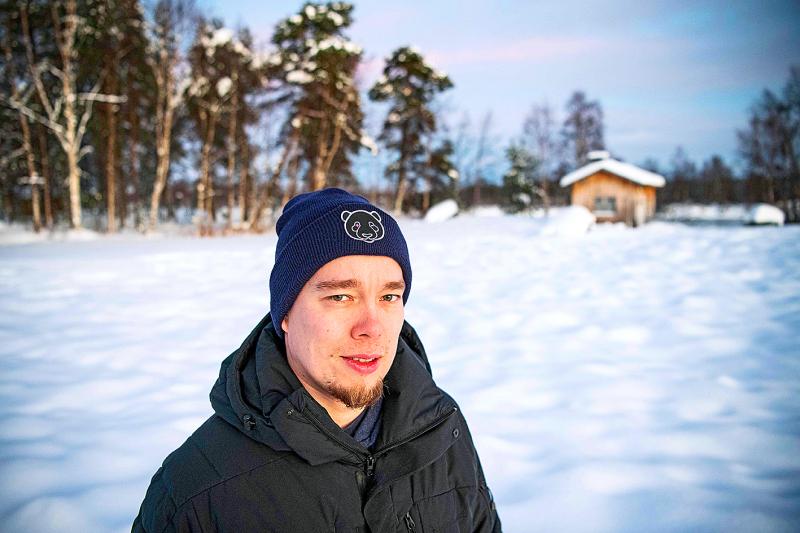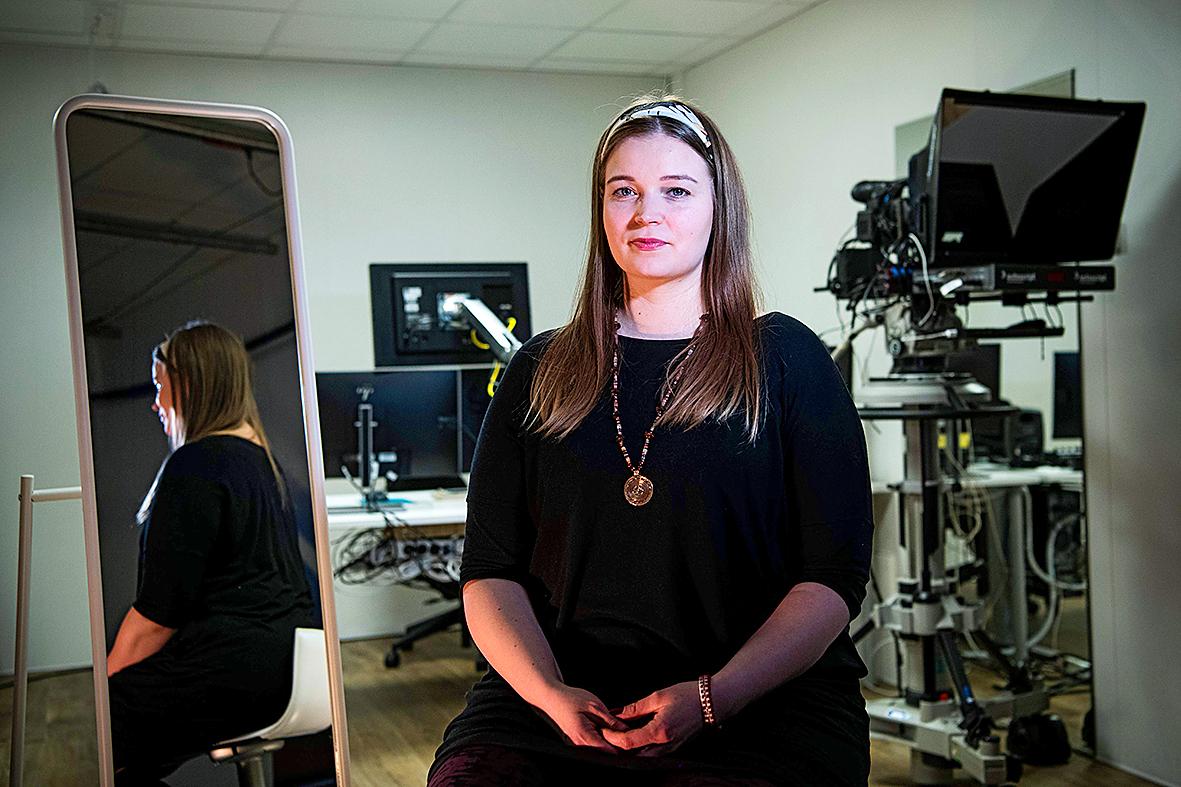Sporting a grey hoodie, goatee beard and oversize headphones, rapper Amoc spits a stream of aggressive, staccato rhymes into the microphone of his home studio as he works on new material.
The punchy rhythm of the 35-year-old’s vocals would sound familiar to rap lovers all over the world.
But Amoc’s lyrics are only understandable to the 300 speakers of the seriously endangered language of Inari Sami, from Finland’s far north.

Photo: AFP
Until the middle of the last century, the 10 languages of the indigenous Sami people — who are spread across the northern parts of Norway, Sweden, Finland and Russia — were decimated by brutal assimilation policies by their governments.
Now, a new generation of young speakers has spawned music, TV program and even a Disney blockbuster, in a “golden age” for Sami languages.
But re-learning the almost-forgotten tongues has stirred up painful memories of past injustices against the Sami.

Photo: AFP
“The more you learn,” says Sami parliament president Tiina Sanila-Aikio, “the more you realize this might be something that you cannot ever take back as a mother tongue.”
SAMI RAP
When Amoc — real name Mikkal Morottaja — started rapping two decades ago, only “10 or fewer” young people could speak his language.

Photo: AFP
His preferred themes of “occultist horror and violence” did not always go down well with the other Inari Sami speakers, who thought his lyrics would be more traditional.
“The older people didn’t realize that it’s not about flowers and nature,” he says. “I don’t think they liked my music so much.”
Morottaja often has to innovate to express modern concepts in a language more tailored to describing indigenous traditions such as reindeer herding.
Inari Sami used to have no word for outer space, for instance. But his father, Matti, an activist and president of the language council, has been able to advise and even help create new constructions.
In the case of “space”, Inari Sami has now adopted komovuota, which literally means “openness”.
Morottaja’s latest project is a collaboration with fellow Sami rapper Ailu Valle.
Valle speaks a different language, Northern Sami, with 25,000 speakers and classed as “endangered” by UNESCO.
The pair have played gigs far beyond Sami-speaking areas: in the US, Canada and around Europe.
Initially inspired by Eminem and the Wu-Tang Clan, Valle first rapped in English and Finnish, avoiding Northern Sami.
“I thought I’d need urban vocabulary,” he says in his remote wooden home on the shore of the frozen Ivalo river.
But learning at university about his culture and its history of oppression sparked a determination to sing in Sami.
“I thought it’s the same as in America,” Valle says. “A minority expressing themselves in their own community and within the bigger society.”
His early songs drew on Sami literature, including the internationally acclaimed poet Nils-Aslak Valkeapaa, whose 1988 epic Beaivi ahcazan (The Sun, My Father) is an intimate and melodic voyage through thousands of years of Sami history.
LANGUAGE NESTS
Until at least the 1960s, Sami children were routinely forbidden to use their mother tongue at school, under an education system that saw Sami people as second-class citizens to be assimilated into mainstream society.
But a gradual shift in attitudes across the Nordic countries resulted in a milestone in 1992, when Finland passed a Sami language law giving speakers the right to use their mother tongue with authorities. Since then, the number of younger speakers has grown thanks to immersive “language nest” schools and nurseries, a policy copied from New Zealand’s Maori language revival.
Yet still only a quarter of the country’s 10,000 Sami speak a Sami language, Finland’s Sami parliament says.
“One major concern is that rights to education and services in Sami only apply in Lapland’s designated Sami region,” parliament’s language protection secretary Anne Kirste Aikio says, “even though over half of Sami live in cities and elsewhere.”
Finland’s center-left government has promised to address the issue, such as by expanding distance and online teaching in Sami. For now, the children’s program Unna Junna is a vital resource.
Produced since 2007 by Finnish broadcaster YLE, each episode covers aspects of Sami life, in all three of Finland’s Sami languages.
Producer Heli Huovinen and her small team sometimes ask viewers and their parents what they would like to see.
“They want more films about nature, about animals, about traditional Sami things and ways of life,” she says. “We were expecting modern things like robots and computer games.”
Huovinen, in her early 30s, grew up with a strong Inari Sami identity but had no opportunities to learn the language until high school.
“It would have been so cool to have Sami children’s TV, I could have learnt from that,” she says. “So I’m very happy that we have children’s TV now.”
But Sami’s growing popularity has also highlighted a shortage of resources and teachers.
“We need more schoolbooks, we need more media, we need more arts and all kinds of support,” Huovinen says.
RETAKING WHAT WAS STOLEN
In a sign that mainstream culture is becoming more widely available in the Sami languages, in December the blockbuster hit Frozen 2 became the first ever Disney film to be dubbed into Northern Sami.
Continuing the adventures of Queen Elsa and Princess Anna, Jiknon 2 — as it is called in Northern Sami — draws heavily on Sami folklore and ways of life.
The sisters embark on a trek through an enchanted forest to meet the tent-dwelling Northuldra tribe, whose clothes and reindeer-herding way of life are distinctly Sami.
The soundtrack, meanwhile, features traditional Sami yoik singing.
Ailu Valle, tasked with translating the film’s song lyrics, describes the release as an “exceptional” moment for Northern Sami children.
Disney’s producers collaborated with Sami leaders to ensure a respectful representation of their culture, and the film has been praised for rejecting the stereotypical depiction of Sami traditions as primitive.
“We have had so many bad examples of our culture being misused,” Sanila-Aikio, Finland’s Sami parliament president, says. “It’s a win-win for all of us and we’re very happy with this collaboration,” she says.
Although Sanila-Aikio talks of a “golden age” of Sami languages, she says the scars of the past remain. The 2016 film Sami Blood, by Sami director Amanda Kernell, won international success with its depiction of the vicious treatment of Sami children by Swedish officials in the 1930s. Nordic governments imposed brutal and often violent regimes which denounced Sami language and culture as uncivilised and devilish, forcing children to assimilate into the majority society.
As a result, many of today’s Sami adults did not have the chance to learn Sami from their parents.
Regaining the languages has meant “taking back something which was stolen,” Sanila-Aikio says. “It brings up very many feelings.”
In a nearby classroom, Iiris Maenpaa is leading a group of eight adult students in a discussion in Inari Sami. The immersive language course which she coordinates at the Sami Educational Institute in Inari is state-subsidised and leaves students largely fluent after 12 months.
Maenpaa followed the course herself eight years ago, aged 30, saying she previously felt like an “outsider” in her own culture.
“I wanted to speak with my grandfather in his mother tongue,” she says.
Until then, the pair could only communicate in Finnish. She had always thought her grandfather sounded a bit angry.
“The first time I spoke with him in Inari Sami, I realized that he doesn’t sound angry at all,” she remembers. “It was life-changing for me.”

June 23 to June 29 After capturing the walled city of Hsinchu on June 22, 1895, the Japanese hoped to quickly push south and seize control of Taiwan’s entire west coast — but their advance was stalled for more than a month. Not only did local Hakka fighters continue to cause them headaches, resistance forces even attempted to retake the city three times. “We had planned to occupy Anping (Tainan) and Takao (Kaohsiung) as soon as possible, but ever since we took Hsinchu, nearby bandits proclaiming to be ‘righteous people’ (義民) have been destroying train tracks and electrical cables, and gathering in villages

This year will go down in the history books. Taiwan faces enormous turmoil and uncertainty in the coming months. Which political parties are in a good position to handle big changes? All of the main parties are beset with challenges. Taking stock, this column examined the Taiwan People’s Party (TPP) (“Huang Kuo-chang’s choking the life out of the TPP,” May 28, page 12), the Democratic Progressive Party (DPP) (“Challenges amid choppy waters for the DPP,” June 14, page 12) and the Chinese Nationalist Party (KMT) (“KMT struggles to seize opportunities as ‘interesting times’ loom,” June 20, page 11). Times like these can

Dr. Y. Tony Yang, Associate Dean of Health Policy and Population Science at George Washington University, argued last week in a piece for the Taipei Times about former president Ma Ying-jeou (馬英九) leading a student delegation to the People’s Republic of China (PRC) that, “The real question is not whether Ma’s visit helps or hurts Taiwan — it is why Taiwan lacks a sophisticated, multi-track approach to one of the most complex geopolitical relationships in the world” (“Ma’s Visit, DPP’s Blind Spot,” June 18, page 8). Yang contends that the Democratic Progressive Party (DPP) has a blind spot: “By treating any

Swooping low over the banks of a Nile River tributary, an aid flight run by retired American military officers released a stream of food-stuffed sacks over a town emptied by fighting in South Sudan, a country wracked by conflict. Last week’s air drop was the latest in a controversial development — private contracting firms led by former US intelligence officers and military veterans delivering aid to some of the world’s deadliest conflict zones, in operations organized with governments that are combatants in the conflicts. The moves are roiling the global aid community, which warns of a more militarized, politicized and profit-seeking trend